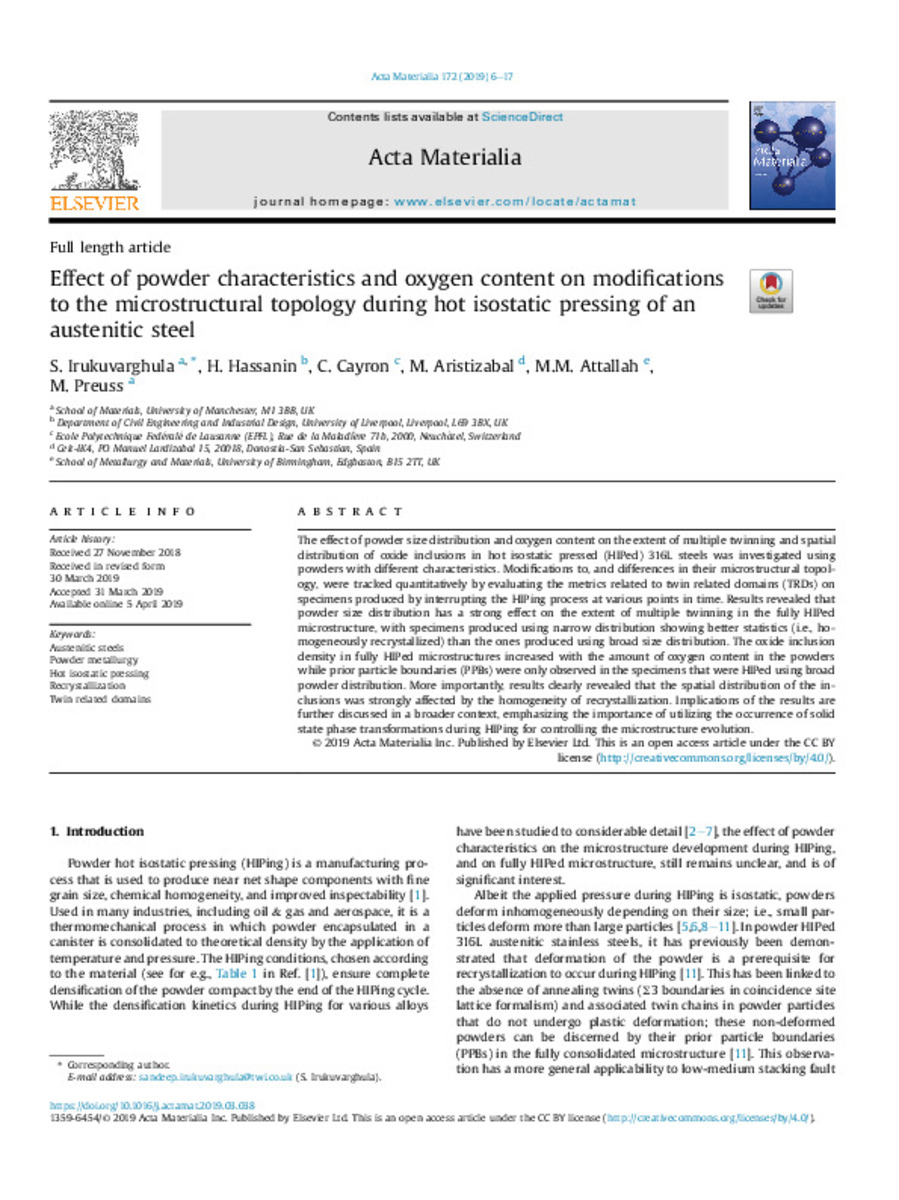Full metadata record
| DC Field | Value | Language |
|---|---|---|
| dc.creator | Irukuvarghula, S. (S.) | - |
| dc.creator | Hassanin, H. (H.) | - |
| dc.creator | Cayron, C. (C.) | - |
| dc.creator | Aristizabal, M. (M.) | - |
| dc.creator | Attallah, M.M. (M. M.) | - |
| dc.creator | Preuss, M. (M.) | - |
| dc.date.accessioned | 2022-01-17T12:25:08Z | - |
| dc.date.available | 2022-01-17T12:25:08Z | - |
| dc.date.issued | 2019 | - |
| dc.identifier.citation | Irukuvarghula, S. (S.); Hassanin, H. (H.); Cayron, C. (C.); et al. "Effect of powder characteristics and oxygen content on modifications to the microstructural topology during hot isostatic pressing of an austenitic steel". Acta Materialia. 172 (2019), 2019, 6 - 17 | es |
| dc.identifier.issn | 1359-6454 | - |
| dc.identifier.uri | https://hdl.handle.net/10171/62732 | - |
| dc.description.abstract | The effect of powder size distribution and oxygen content on the extent of multiple twinning and spatial distribution of oxide inclusions in hot isostatic pressed (HIPed) 316L steels was investigated using powders with different characteristics. Modifications to, and differences in their microstructural topology, were tracked quantitatively by evaluating the metrics related to twin related domains (TRDs) on specimens produced by interrupting the HIPing process at various points in time. Results revealed that powder size distribution has a strong effect on the extent of multiple twinning in the fully HIPed microstructure, with specimens produced using narrow distribution showing better statistics (i.e., homogeneously recrystallized) than the ones produced using broad size distribution. The oxide inclusion density in fully HIPed microstructures increased with the amount of oxygen content in the powders while prior particle boundaries (PPBs) were only observed in the specimens that were HIPed using broad powder distribution. More importantly, results clearly revealed that the spatial distribution of the inclusions was strongly affected by the homogeneity of recrystallization. Implications of the results are further discussed in a broader context, emphasizing the importance of utilizing the occurrence of solid state phase transformations during HIPing for controlling the microstructure evolution. | es_ES |
| dc.description.sponsorship | The authors would like to thank the EPSRC for funding through New Nuclear Manufacturing (NNUMAN): EP/J021172/1, and Manufacture using Advanced Powder Processes (MAPP): EP/ P006566/1. Rolls-Royce is also thanked for supplying the 316L forging for this study. | es_ES |
| dc.language.iso | eng | es_ES |
| dc.publisher | Elsevier BV | es_ES |
| dc.rights | info:eu-repo/semantics/openAccess | es_ES |
| dc.subject | Austenitic steels | es_ES |
| dc.subject | Powder metallurgy | es_ES |
| dc.subject | Hot isostatic pressing | es_ES |
| dc.subject | Recrystallization | es_ES |
| dc.subject | Twin related domains | es_ES |
| dc.title | Effect of powder characteristics and oxygen content on modifications to the microstructural topology during hot isostatic pressing of an austenitic steel | es_ES |
| dc.type | info:eu-repo/semantics/article | es_ES |
| dc.description.note | Published by Elsevier Ltd. This is an open access article under the CC BY license (http://creativecommons.org/licenses/by/4.0/) | es_ES |
| dc.identifier.doi | 10.1016/j.actamat.2019.03.038 | - |
| dadun.citation.endingPage | 17 | es_ES |
| dadun.citation.number | 2019 | es_ES |
| dadun.citation.publicationName | Acta Materialia | es_ES |
| dadun.citation.startingPage | 6 | es_ES |
| dadun.citation.volume | 172 | es_ES |
Files in This Item:
Statistics and impact
Items in Dadun are protected by copyright, with all rights reserved, unless otherwise indicated.






